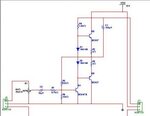boylesg
Advanced Member level 4

- Joined
- Jul 15, 2012
- Messages
- 1,023
- Helped
- 5
- Reputation
- 10
- Reaction score
- 6
- Trophy points
- 1,318
- Location
- Epping, Victoria, Australia
- Activity points
- 11,697

I assume R4 is the collector resistor for the class A common emitter (voltage gain) part of the amplifier (Q1).
And that R4 is in that position because it is the only place it can go with interfering with the class B part of the amplifier (Q2 & Q3)
However, class A common emitter amplifiers, by themselves, usually have an emitter resistor but they never seem to have one when they are part of a class AB amplifier. Why is that so?
And the other bit that I don't quit have my head around is the connection of R4 to the junction between Q2 and Q3 (through (C1). I understand that it is feedback, but why is it needed? What would happen if you connected R4 to Vcc, as is normally the case with a class A amplifier?





